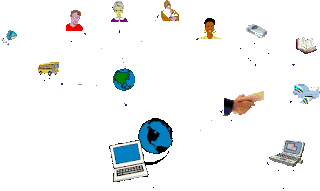Digital
divide is an economic and social inequality with regard to access to, use of,
or impact of information and communication technologies (ICT). The divide
within countries (such as the digital divide in the United States) may refer to
inequalities between individuals, households, businesses, or geographic areas,
usually at different socioeconomic levels or other demographic categories. The
divide between differing countries or regions of the world is referred to as
the global digital divideexamining this technological gap between developing
and developed countries on an international scale.The infrastructure by which
individuals, households, businesses, and communities connect to the Internet
address the physical mediums that people use to connect to the Internet such as
desktop computers, laptops, basic mobile phones or smart phones. Traditionally the nature of the divide has
been measured in terms of the existing numbers of subscriptions and digital
devices.
However,
research shows that the digital divide is more than just an access issue and
cannot be alleviated merely by providing the necessary equipment. There are at
least three factors at play: information accessibility, information utilization
and information receptiveness. More than just accessibility, individuals need
to know how to make use of the information and communication tools once they
exist within a community.
Information
professionals have the ability to help bridge the gap by providing reference
and information services to help individuals learn and utilize the technologies
to which they do have access, regardless of the economic status of the
individual seeking help.Internet connectivity can be utilized at a variety of
locations such as homes, offices, schools, libraries, public spaces, Internet
cafe and others. There are also varying levels of connectivity in rural,
suburban, and urban areas. Digital divide may exist for a number of reasons.
Obtaining access to ICTs and using them actively has been linked to a number of
demographic and socio-economic characteristics: among them income, education,
race, gender, geographic location (urban-rural), age, skills, awareness, and
political, cultural and psychological attitudes. Most commonly, a
digital divide stems from poverty and the economic barriers that limit
resources and prevent people from obtaining or otherwise using newer
technologies.
Community Informatics
(CI) provides a somewhat different approach to addressing the digital divide by
focusing on issues of "use" rather than simply "access". CI
is concerned with ensuring the opportunity not only for ICT access at the
community level. Connecting to the Internet creates another set of means by
which to achieve repeated interactions. ICTs and Internet connectivity enable
repeated interactions through access to social networks, chat rooms, and gaming
sites. Once an individual has access to connectivity, obtains infrastructure by
which to connect, and can understand and use the information.
New applications have
made it possible for anyone with a computer and an Internet connection to be a
creator of content, yet the majority of user generated content available widely
on the Internet, like public blogs, is created by a small portion of the
Internet using population. Technologies like Facebook, YouTube, Twitter, and
Blogs enable users to participate online and create content without having to
understand how the technology actually works, leading to an ever increasing
digital divide between those who have the skills and understanding to interact
more fully with the technology.
The more frequently a
person has access to the Internet and the faster the connection, the more
opportunities they have to gain the technology skills and the more time they
have to be creative that ICTs and connectivity provide, that individual is
capable of becoming a "digital citizen.
The global digital
divide also contributes to the inequality of access to goods and services
available through technology. Computers and the Internet provide users with
improved education, which can lead to higher wages; the people living in
nations with limited access are therefore disadvantaged.Telephone is often seen
as one of the most important components, because having access to a working
telephone can lead to higher safety.Computer and Internet use is regarded as
being very important to development and success. However, some children are not
getting as much technical education as others, because lower socioeconomic
areas cannot afford to provide schools with bundles of computers.
Moreover,
they say that with the help of modern technology people can artificially create
conditions that will allow people to live there on the constant basis. To sum
up, I am sure that many amazing changes will be brought by it. Furthermore, I
think that with the help of the contemporary technologies people can do many
things that were even difficult to imagine a century ago. So, nowadays it is
rather difficult and even impossible to imagine all changes that will happen in
the next decades.Indeed given us a lot of advantages by making us richer,
healthier, and freer to enjoy our lives, it has, in my opinion, not made us
wiser. The 21st century has also made our earth dirtier, our people less
humane, and our spiritual lives poorer. We should continue to enjoy the
benefits of technological advancements because they free us to pursue our
interests and goals. However, we must make a concerted effort to preserve our
natural environment for future generations. Moreover, we should take the time
now to make our lives more meaningful in an increasingly impersonal,
computerized world.










